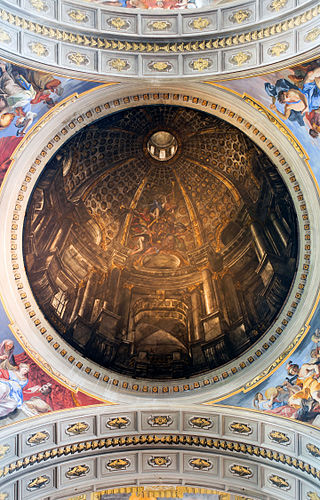
Mantua is a comune (municipality) in the Italian region of Lombardy, and capital of the province of the same name.

Antonio Allegri da Correggio, usually known as just Correggio was an Italian Renaissance painter who was the foremost painter of the Parma school of the High Italian Renaissance, who was responsible for some of the most vigorous and sensuous works of the sixteenth century. In his use of dynamic composition, illusionistic perspective and dramatic foreshortening, Correggio prefigured the Baroque art of the seventeenth century and the Rococo art of the eighteenth century. He is considered a master of chiaroscuro.

Andrea Mantegna was an Italian painter, a student of Roman archeology, and son-in-law of Jacopo Bellini.

The Duchy of Mantua was a duchy in Lombardy, northern Italy. Its first duke was Federico II Gonzaga, member of the House of Gonzaga that ruled Mantua since 1328. The following year, the Duchy also acquired the March of Montferrat, thanks to the marriage between Gonzaga and Margaret Paleologa, Marchioness of Montferrat.

Giovanni Benedetto Castiglione was an Italian Baroque painter, printmaker and draftsman, of the Genoese school. He is best known now for his etchings, and as the inventor of the printmaking technique of monotyping. He was known as Il Grechetto in Italy and in France as Le Benédette.

Illusionistic ceiling painting, which includes the techniques of perspective di sotto in sù and quadratura, is the tradition in Renaissance, Baroque and Rococo art in which trompe-l'œil, perspective tools such as foreshortening, and other spatial effects are used to create the illusion of three-dimensional space on an otherwise two-dimensional or mostly flat ceiling surface above the viewer. It is frequently used to create the illusion of an open sky, such as with the oculus in Andrea Mantegna's Camera degli Sposi, or the illusion of an architectural space such as the cupola, one of Andrea Pozzo's frescoes in Sant'Ignazio, Rome. Illusionistic ceiling painting belongs to the general class of illusionism in art, designed to create accurate representations of reality.

St. Sebastian is the subject of three paintings by the Italian Early Renaissance master Andrea Mantegna. The Paduan artist lived in a period of frequent plagues; Sebastian was considered protector against the plague as having been shot through by arrows, and it was thought that plague spread abroad through the air.
The School of Ferrara was a group of painters which flourished in the Duchy of Ferrara during the Renaissance. Ferrara was ruled by the Este family, well known for its patronage of the arts. Patronage was extended with the ascent of Ercole d'Este I in 1470, and the family continued in power till Alfonso II, Ercole's great-grandson, died without an heir in 1597. The duchy was then occupied in succession by Papal and Austrian forces. The school evolved styles of painting that appeared to blend influences from Mantua, Venice, Lombardy, Bologna, and Florence.
The decade of the 1460s in art involved some significant events.

Giovanni Antonio da Brescia was an Italian engraver of northern Italy, active in the approximate period 1490–1519, during the Italian Renaissance. In his early career he used the initials "Z.A." to sign some twenty engravings, and until recently Zoan Andrea was regarded as a distinct printmaker; it is now realized that they are the same person, and the "Z.A." stood for Giovanni Antonio, "Zovanni" being a north Italian spelling. Around 1507 he began to use formulae such as "IO.AN.BX.", and signed some prints more fully. The real Zoan Andrea was a very obscure painter, documented as working in Mantua in the 1470s, who produced no engravings.

The Camera degli Sposi, sometimes known as the Camera picta, is a room frescoed with illusionistic paintings by Andrea Mantegna in the Ducal Palace, Mantua, Italy. During the fifteenth century when the Camera degli Sposi was painted, Mantua was ruled by the Gonzaga, who maintained Mantua's political autonomy from its much stronger neighbors Milan and Venice by bidding their support out as a mercenary state. By commissioning Mantegna to paint the chamber, Ludovico III Gonzaga, the Marquis of Mantua, sought to give the Gonzaga rule more cultural credibility at a time when other Northern Italian courts such as the Ferrara were commissioning their own “painted chambers”.

The Battle Between Love and Chastity is a painting by the Italian Renaissance artist Pietro Perugino, now in the Musée du Louvre, in Paris, France. It was originally commissioned for the studiolo (cabinet) of Isabella d'Este, Marchesa of Mantua, in the Castello di San Giorgio.

The Portrait of Carlo de' Medici is a painting by the Italian Renaissance master Andrea Mantegna, executed in 1466. It is now housed in the Uffizi Gallery of Florence.

The Rest on the Flight into Egypt with Saint Francis is a painting by the Italian Renaissance master Correggio, dated to c. 1520 and now in the Uffizi Gallery of Florence. The Rest on the Flight into Egypt was a popular subject in art.

The Pinacoteca del Castello Sforzesco is an art gallery in the museum complex of the Castello Sforzesco in Milan, northern Italy.

The Camera di San Paolo or Camera della Badessa is a room in the former Monastery of San Paolo, in Parma, northern Italy. It is painted with frescoes by Correggio in the vault (697x645 cm) and over the fireplace.

The Barrymore Madonna is a 1508–1510 painting by the Italian Renaissance artist Antonio da Correggio.

The Campori Madonna is an oil-on-panel painting executed ca. 1517–18 by the Italian Renaissance painter Antonio da Correggio.

The Mantegna funerary chapel is one of the chapels of the Basilica of Sant'Andrea, Mantua. It houses the tomb of the painter Mantegna and his last two paintings – Baptism of Christ and Holy Family with St John the Baptist, St Elizabeth and St Zacharias (1504–1506). Its frescoes from 1507 were painted by his sons Ludovico and Francesco and by a young Correggio. The tomb bears a bronze figure of Mantegna by Gianmarco Cavalli.

















